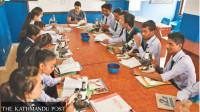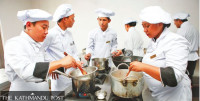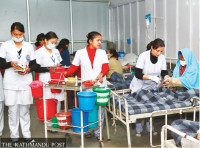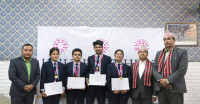Miscellaneous
Under the microscope
In May, a three-member team that included a police official, a doctor and an educator visited Bihar, India with a mission in mind. They carried with them a heap of certificates of doctors registered with the Nepal Medical Council (NMC), the government body tasked with regulating medical education and doctors in the country.
Manish Gautam
In May, a three-member team that included a police official, a doctor and an educator visited Bihar, India with a mission in mind. They carried with them a heap of certificates of doctors registered with the Nepal Medical Council (NMC), the government body tasked with regulating medical education and doctors in the country.
In the 10 days they stayed in the North Indian state, the team made their way to the office of the Bihar Intermediate Education Council (BIEC) to verify the certificates they had brought along. A team of officials from the BIEC supported the Nepali contingent, often putting in 8-hour shifts—verifying the certificates digitally, when available, or by manually sifting through stack of old binders. In the end, the team’s suspicions were confirmed: Among the 1,000 certificates, 109 of them did not match the original documents filed with the BIEC.
“If once being a doctor implied that you were a ‘brilliant mind’, that is not the case today,” said one of the team members, in a conversation with the Post. “Now, we have the ‘crooked minds’ practicing medicine as well. Over 10 percent of the doctors we verified on the trip had falsified records.”
Among them, there were no records for 14 of the doctors with the BIEC, while 16 were found to have tampered with their grades. Similarly, two doctors, who had been marked absent in the exams, had received flattering grades, while three had ‘fake’ candidates appear in the BIEC examinations in their stead. One of the doctors was found to have used an NMC number of another doctor.
Once the trio returned to the Capital with their findings, a manhunt ensued. In a series of extensive three-day raids in the second week of June, the Central Investigation Bureau (CIB) officials were alarmed to find that some of these doctors were treating patients in Intensive Care Units, while others were taking on sensitive cases in OPDs. A handful of the unverified doctors were performing complex surgeries as well. More troubling yet, a majority of the doctors were not working out of dingy, back-alley clinics; a good number of them were employed with reputed Kathmandu-based hospitals; others in government-run hospitals.
“Operation Quack”, as the detention have come to be known as, have seen a total of 54 arrests.
Snowballing investigation
The chain of events that led to one of the biggest medical scandals in the country’s history was set in motion on an unsuspecting November morning. That Saturday, NMC was holding its routine licensing examination—a standardised test all MBBS graduates are required to pass in order to practice—at Chauni, Kathmandu. Upon closer examination, it was discovered that two of the attendees did not match the official entries. One of them, an intern doctor at the Institute of Medicine (IoM), was in attendance in place of Nabin Kumar Yadav—a candidate who had flunked eight successive attempts at the exam. Another candidate, Saroj Shah—who had failed to attain the license in 12 attempts—was represented by a ‘fake’ candidate as well.
Although rumours of fake certificates had been rife in the medical community for a while, only a handful of doctors had been booked on the charges before the November incident. Yet, the discovery was serendipitous, as it was alarming. In the months leading up to the examination, NMC had come under fire for its poor regulation of medical colleges, with many demanding the dissolution of the government body itself. As a result, the council had asked its invigilators to remain extra vigilant to soothe naysayers.
That one memo would set in motion an investigation, the likes and scale of which had not been undertaken in Nepal’s medical history.
In months following the ousting of the ‘fake’ candidates, a joint operation of the CIB, NMC and the Higher Secondary Education Board (HSEB), arrested 17 doctors in February on charges of possessing fake academic credentials, a majority of whom had failed the council’s exams well over 10 times.
License to heal
The Nepal Medical Council was established in 1965 and has issued license numbers for all practicing doctors ever since. The initial batch of doctors who applied for the licenses had all completed their medical studies in India—with a few who had gone to schools beyond. At the time, a simple furnishing of the required certificates merited a licence.
Up until 1971, Nepali students had little options but to go abroad for their medical studies, with only a handful of institutions in the country offering nursing and rudimentary health courses. A year later, the Institute of Medicine (IoM), under the Tribhuvan University (TU), was formed and handed the authority to conduct and oversee all basic health courses, such as those for health assistants. Nepal’s first MBBS programme was initiated by IoM in 1978.
Sixteen years after the government-affiliated institutions began offering MBBS courses, BP Koirala Institute of Health Sciences and Manipal College of Medical Sciences became the first private institutions to obtain licenses to initiate programmes of their own and over the decades that number has steadily increased. Today, 21 different medical colleges offer MBBS and dental courses in Nepal, producing 2,500 doctors every year.
Following the boom in the number of medical schools and doctors, the NMC began conducting its own licensing examinations in 2002. The system, however, remained inefficient, with lax regulations meaning that a disconcerting number of license numbers are still unaccounted for. Dr Dilip Sharma, Registrar of NMC confirmedthat NMC currently has 50 licenses whose bearer is unknown. He points out that many records were destroyed during the 1973 fire at Singha Durbar and the missing links can be traced back to the data that was lost to the flames. “The numbers were issued at various points of time,” said Dr Sharma. “We don’t know who the original bearers are and the chances are high that these licenses are being misused.”
Dr Sharma assured that since NMC has now digitalised their data and are updating the details of its doctors, the issue will be resolved soon.
False starts
 Yet, investigators are aware that the ‘quack’ doctor issue extends well beyond the discrepancies found at the licensing examinations. In 2013, the IoM, the country’s flagship medical school, discovered that an Indian national pursuing his postgraduate studies in Radiology was not the student who sat for the entrance examination, a prerequisite for enrolling into the course.
Yet, investigators are aware that the ‘quack’ doctor issue extends well beyond the discrepancies found at the licensing examinations. In 2013, the IoM, the country’s flagship medical school, discovered that an Indian national pursuing his postgraduate studies in Radiology was not the student who sat for the entrance examination, a prerequisite for enrolling into the course.
Officials say that it is highly likely that ‘fake’ examinees have taken MBBS entrance exams on behalf of other students in past years. This issue has seen renewed interest after four of the recently arrested doctors were found to have studied in Nepali medical colleges, including the prestigious IoM.
All of the students who enrol into Nepal’s medical schools are required to pass an entrance examination with the Tribhvan University or the Kathmandu University. However, neither of the two universities have mechanisms that extensively verify the authenticity of the certificates presented by the applicants.
According to Dr Bimal Sinha, Acting Dean of IoM, the possibility that fake candidates might have taken exams for other students cannot be ruled out. “The screening process is rigorous for Indian students. But since we have thousands of Nepalis applying each year, we don’t have the resources or the capacity to conduct such verification,” said Dr Sinha.
He, however, expects the verification to become more stringent in the coming years. IoM recently introduced fingerprint verifications of all the applicants to its postgraduate courses, with the view of eventually extending the filter to MBBS applicants as well.
Apart from this, one of the doctors arrested in February allegedly bought not just his higher secondary degree but also his MBBS certificate from India—opening another Pandora’s box altogether.
“The chances of acquiring MBBS certificates must be low. But we cannot rule that out,” said Dr Sharma.
Down the rabbit hole
Following the arrest of doctors in February, the NMC has initiated the herculean task of scrutinising the certificates of all its 18,000 registered doctors. This verification is primarily done by the HSEB and the Office of the Controller of Examinations (OCE). In the case of foreign degree holders, the verification of certificates obtained through the BIEC have been complete, with the focus now shifting to other Indian education boards as well.
Officials involved in investigation believe that the number of doctors with fake academic credentials might amount to as many as 2,000 individuals.
No silver bullet
Dr Sushil Koirala, a dentist and a medical ethicist, insists that the problem goes beyond just a “few rotten apples” and tugs at a larger societal concern. He argues that a student usually joins medical schools as a teenager and that fake certificates are usually obtained with the tacit approval, if not active participation, of their parents and guardians.
He also points out that until very recently it was incredibly easy for a student with poor grades to skip the border into Bihar and obtain fake certificates on par with the unreasonable grades demanded by medical schools.
“This reveals a disturbing reality of our society: The desperation of parents who want their children to become doctors—by hook or by crook,” said Dr Koirala. “This not only mounts extreme pressure on the children but it also casts an impression that doctors are some sort of superior human beings—a perception many doctors unfortunately carry long into their careers.”
Middle class families who view having a doctor in the family as a tool for social mobility have also been a major factor in boosting such malpractices, adds Dr Koirala. Each year, despite the proven scope of various other professions, a staggering 5,000 students apply for MBBS programmes across the country. The number is higher in tuition centres that prepare students for entrance exams, where around 7,000 students enrol every year.
With the recent arrests and the ensuing scandal rattling Nepal’s medical community, Dr Jagdish Agrawal, a medical educator, reiterates the need of a special department at the NMC that verifies certificates. He believes that conducting standardised entrance examinations and employing biometric technology for verification will further help curb some of the malpractices.
Dr Koirala also believes that the verification needs to be more stringent and that the current investigations end as soon as possible so that genuine doctors can work without hesitation. “There is, understandably, a lot of public apprehension that their doctors might be ‘fake.’ In the medical profession, trust is paramount. It is the fundamental building block of the doctor-patient relationship. While this investigation has been immensely helpful in outing ‘quacks’ practicing with little regard to the lives they are playing with, it cannot drag on for years like other investigations. That would be devastating for the medical community, and particularly for professionals who have stayed true to their Hippocratic oaths.”





 22.12°C Kathmandu
22.12°C Kathmandu










